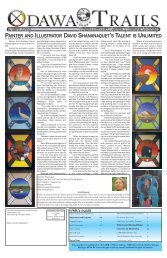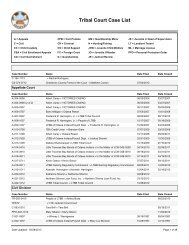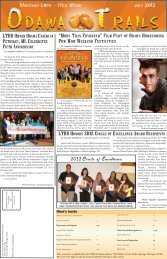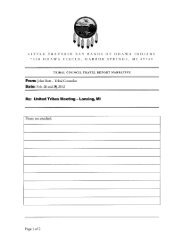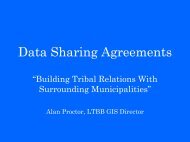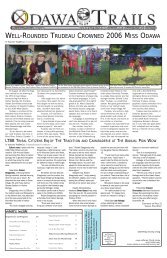LTBB Master Land Use Plan - Little Traverse Bay Bands of Odawa ...
LTBB Master Land Use Plan - Little Traverse Bay Bands of Odawa ...
LTBB Master Land Use Plan - Little Traverse Bay Bands of Odawa ...
Create successful ePaper yourself
Turn your PDF publications into a flip-book with our unique Google optimized e-Paper software.
tranquility <strong>of</strong> the lakes are all part <strong>of</strong> the natural ambiance <strong>of</strong> Emmet County. These resources also<br />
contribute to a viable recreational economy.”<br />
Watershed Boundari es<br />
Map 24 displays boundaries for major watersheds located within and adjacent to The <strong>LTBB</strong><br />
treaty delineated reservation area. A watershed is the area <strong>of</strong> land that catches rain and snow and<br />
drains or seeps into a marsh, stream, river, lake or groundwater. Watersheds are inherently defined<br />
by topography as water always follows the path <strong>of</strong> least resistance. As a result, all activities within a<br />
watershed affect the quality <strong>of</strong> water as it percolates through and runs across developed landscapes.<br />
The reservation area is divided by two large watersheds: Lake Michigan to the West and Lake Huron<br />
to the East.<br />
Domestic Well Water Depth<br />
This map <strong>of</strong> domestic well water depths (Map 25) illustrates the dependence <strong>of</strong> the surrounding<br />
area on groundwater quality. Every citizen <strong>of</strong> this region is dependent on ground water for their<br />
drinking water source. The quality and quantity <strong>of</strong> these resources are important to the Tribe and<br />
surrounding community members for more then just our household uses. These vast aquifers are the<br />
driving force <strong>of</strong> the areas environmental and economic health. Thousands <strong>of</strong> people travel to this<br />
area each year for the beauty <strong>of</strong> our lakes and Rivers and the prolific wildlife that abounds due to<br />
groundwater’s influence on surface bodies <strong>of</strong> water.<br />
Without adequate ground water the health <strong>of</strong> our lakes, rivers and wetlands would be<br />
dramatically affected. Many <strong>of</strong> the <strong>LTBB</strong> Tribal members depend on fishing, hunting, and gathering<br />
for cultural and subsistence motives. This way <strong>of</strong> life is depended on groundwater quality. The<br />
tourist that visit the Tribal businesses and developments that located in this area come indirectly<br />
because <strong>of</strong> groundwater’s affect on our surface water. The biggest threats to this resource is failing<br />
septic systems, and leaking underground storage tanks. Protecting this resource is important for the<br />
long term health <strong>of</strong> Tribal members.<br />
Prime Farmlands<br />
The ‘Prime Farmlands’ map (Map 26) represents prime agricultural lands within Emmet and<br />
Charlevoix counties. The <strong>LTBB</strong> reservation boundary falls within this geographic context.<br />
Prime farmland is defined by the USDA as “land that has the best combination <strong>of</strong> physical and<br />
chemical characteristics for producing food, feed, forage, fiber, and oilseed crops. Prime farmland<br />
has the soil quality, growing season, and moisture supply needed to economically produce sustained<br />
high yields <strong>of</strong> crops when treated and managed according to acceptable farming methods.”<br />
(Watershed Resource Papers, Lang worthy, Strader & LeBlanc & Associates, Inc.)<br />
Preserving farmland is becoming increasingly difficult. The irony <strong>of</strong> this issue is that many nonfarming<br />
residents want to preserve existing farmlands, while farmers themselves may also want to<br />
preserves their farms, but at the same time want to retain their right to sell.<br />
From an environmental perspective, agricultural lands can <strong>of</strong>fer floodplain protection, areas <strong>of</strong><br />
groundwater recharge and wildlife habitat. From a development perspective, agricultural lands can<br />
<strong>of</strong>fer a low to flat developable surface, large parcel sizes and a willing seller. Indeed, some farmers<br />
have begun to view their land holdings as a land retirement accounts.<br />
24



